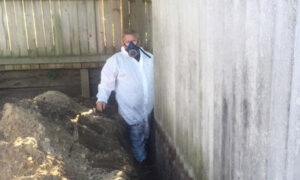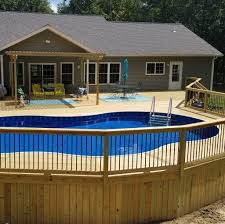A crumbling asbestos fence is a serious health hazard for homeowners, their families, and neighbors. It contains tiny carcinogenic fibers that can be inhaled and lead to life-threatening diseases, including mesothelioma and lung cancer. For more infomation visit Asbestos Perth.
If a property was built before 1990, there is a chance that the fencing could contain Asbestos; however, after 1990, it is more likely to be Hardifence made from concrete or cellulose fiber rather than Asbestos.

When it comes to asbestos fences, the age of the material is a key factor. The older a fence is, the more likely it is to contain dangerous asbestos fibers. The material has had time to break down and contaminate the surrounding area.
These homes were often found in poorer areas of town, with government housing departments making entire suburbs of fibro. Asbestos was also used for fencing products, as it is sturdy and fire-resistant.
The problem is that old fences made with fibro and other asbestos-containing materials pose a risk to the health of those living near them, especially if they are broken or disturbed in any way. This is why it is important only to use professional services for asbestos removal in Perth. The team at Asbestos Safety Testing will be able to identify whether your fence contains Asbestos and how much of it is present so you can take the appropriate precautions.
One of the easiest ways to tell if your asbestos fence is still safe is to look for a metal capping at the top. Fences fitted with capping that is not Asbestos are likely to be made of concrete or cellulose fiber, less dangerous than Super Six asbestos. If you are unsure, use your fingernail to scratch the surface of the sheeting. If you cannot make a mark, then it’s probably Asbestos and will need to be removed.
If your fence is uncapped, you should be extra cautious when working near it. The best thing you can do is to contact a professional for inspection and testing. This will ensure that the service you receive is reputable and compliant with all regulations. When choosing a professional, ask for references from previous clients and check their credentials before hiring them. This will help you avoid any scams and ensure that the work is completed correctly.
Asbestos was once commonly used in construction, particularly as a fire-resistant material. It was known for its strength, tensile and electrical insulation properties, and chemical inertness. The problem is that it also deteriorates easily and can release dangerous asbestos fibers into the air when exposed to heat, water, or weather damage. When these fibers are inhaled, they can cause serious health problems, including lung cancer and deadly mesothelioma.
Because of the ease with which these fibers are released, ensuring that building materials, such as fences, do not contain Asbestos is very important. A licensed contractor must properly remove any asbestos-containing material (ACM) to prevent contamination. A licensed contractor will put appropriate health and safety precautions in place for the removal and disposal of Asbestos, as well as ensure the job is completed safely.
A licensed contractor can provide peace of mind when removing an asbestos fence and installing new Colorbond fencing. They can offer expert advice, including the best material to use in its place. In many cases, the removal of an old asbestos fence can be achieved without the need to dig holes or disturb soil underneath it. This means that the cost and time for removal can be kept to a minimum.
If an asbestos fence is in good condition and has not been damaged by the elements, it may be possible to repair rather than remove it completely. However, it is important to have any damaged or suspected Asbestos fenced tested for safe handling. This will help to identify any dangerous particles that could be present so they can be properly removed and disposed of by a licensed professional.
The most common method for determining whether or not a fence contains Asbestos is to look at the number of ridges on the sheeting. A fence free of Asbestos will have five ridges, while a ‘Super Six’ non-asbestos fibro fencing will have seven. However, it is important to note that early Hardifence products were molded with a similar profile to Super Six, and as such, this test cannot distinguish between them and Asbestos.
Asbestos was commonly used in various construction applications, and it was very popular as it was inexpensive and easy to work with. The best-known asbestos products were insulation materials, fire retardant boards, and sheeting. Often, these products were combined with cement and shaped to form specific shapes. These were usually found in ceilings and walls of industrial and commercial buildings, school classrooms, warehouses, and domestic homes. Various other forms of Asbestos were also used. These included millboard and fibro sheeting. Asbestos mastic putty was frequently used in high-humidity areas such as wall and ceiling linings. It was a dark grey to brown in color and flexible.
If a homeowner suspects that their fence may contain Asbestos, they should always call in professionals to conduct a safe and thorough inspection. However, there are a few quick checks that can be done. Firstly, check the edge of the fencing sheet. Older ‘Super Six’ fencing sheets have seven ridges per one-meter panel, whereas newer Hardifence (non-asbestos) fencing has only 5.
A good way to tell the difference is to use a magnifying glass or a macro setting on your camera. Hardifence has a slightly more layered appearance and a softer texture than Super Six. Another good test is to scratch the surface of the capping. If it’s fiber cement, then it’s likely an older ‘Super Six’ asbestos fence, whereas a metal capping indicates that it is ‘Hardifence.’
The main danger with a damaged asbestos fence is the possibility of loose fibers becoming airborne and inhalable. This is why it is always important to enlist a licensed professional for asbestos fence removal in Perth. The professional will ensure that all health and safety standards are followed during the entire process and that the contaminated materials are safely removed, transported, and disposed of.
For more information on removing an asbestos fence or installing Colorbond fencing, contact Firm Fencing today. We offer a fast turnaround time and detailed job completion. We specialize in both residential and commercial fencing, and our services include both installation and removal of Asbestos.
Asbestos fences in good condition and not being disturbed pose no health risk. However, if the fencing is damaged or deteriorates, it may become friable and should be removed by a licensed asbestos removalist.
Paint is usually used to protect asbestos fences and can be an easy way to disguise the damage of an old asbestos fence. Paint can be applied to the entire surface of an asbestos fence or the individual sections of the fence. Ideally, the fence should be painted in a color that blends with the surrounding environment and any existing paintwork. Using a non-toxic acrylic, water-based paint is preferred as it is less hazardous than an oil-based product.
A paint job on asbestos fences should be completed with the appropriate PPE and RPE, including a face mask to prevent exposure to paint vapors/mist. A class P1 or P2 half-face respirator is generally recommended for painting Asbestos as it will reduce the amount of dust inhaled while still allowing sufficient airflow. Respirators are also essential when working on asbestos surfaces, such as drywall, textured ceilings, and siding.
Over time, the fungus can build up on unpainted asbestos cement, and this needs to be removed by gentle scraping and simultaneous low-pressure water washing. This process must be repeated frequently to keep the fungus at bay. Using a chemical fungicide will also help to control the growth of fungus on an asbestos roof or fence.
The best way to tell if your fence is Asbestos or not is to get it tested. However, there are some quick tests you can do to check. One is to look at the ridges on the sheeting; modern Hardifence and non-asbestos Super Six have five ridges, while older Asbestos or Super Six fences will have seven.
Asbestos is a versatile mineral widely used in many applications because of its tensile strength, insulation from heat and electricity, and chemical inertness. Asbestos can be found in roofing, cladding, wallpaper, shingles, ceiling and floor tiles, insulation, and car parts. If you have undertaken tests, removal, or remediation of Asbestos on your property, you can claim a tax deduction. This applies to rental properties, businesses, and homeowners who own their homes that are also their place of business.

